
The revolution starts today
The energy transition is fully underway around the world, with a major shift from fossil fuels to renewable sources. Spurred by breakneck innovation, a tide of capital and evolving regulation, business models are developing rapidly, forging new equations for creating value. As companies and investors place decarbonisation at the centre of their strategy, societal and consumer pressures compel new forms of collaboration.
The 2015 Paris Agreement and the recent net zero pronouncements by both China and the United States have transformed governments from cheerleaders of decarbonisation to directors of the transition. From South Korea to the US and Europe, massive economic stimulus packages that are intended to spur a comeback from the pandemic are aimed at building more resilient and sustainable economies and energy systems.
The forces of policy, investment and technological change have put into a place a set of dynamics not seen in energy sectors since the Industrial Revolution. In the coming decade, new energy systems will start to emerge. Industries such as oil and gas, power and utilities, and chemicals, once sharply delineated, will converge and form into integrated energy systems. New industrial clusters will arise, spurred by the advent of novel vectors forged by renewable molecules and electrons. Investors will deploy vast sums of capital.
The ways electrons and molecules are created, the way they move through systems, how they’re stored and their ultimate end use—this dynamic set of forces will forge new paths. They will lead to integrated networks that facilitate the flow of many energy types, creating new business clusters; the formulation of innovative strategies; and a host of responses from the public and private sectors. Going forward, the state and the market must learn how to collaborate as they move into this uncertain future, and participants will need to fundamentally rethink the relative efficacy of a purely market-based approach and accept the guidance and orchestration of markets over the next decades.
US$13tn
will be needed to bolster power transmission and distribution networks across the globe through 2050.
US$2tn
PwC’s lowest estimate of the cost of transforming the electricity networks in Europe over the next 30 years.
US$500bn
will be spent by 2030 just on infrastructure for the nascent hydrogen export market.1
How can we invent tomorrow's energy system?
The transition to Tomorrow's Energy System is already well underway. If our systems are to deliver on the ambitious climate change agenda the world has set, the work must begin now.
For a visual overview of what our new report is about - watch this short animated video. This gives an impressive overview of the main findings.
The world needs more energy
The International Energy Agency projects that total global demand for the molecules and electrons that power our world will rise by 23% by 2040. In the near term, fossil fuels will continue to account for a large percentage of the molecules that fuel transport and the electrons that provide electricity and heat. But, taking a longer view, the direction of the energy transition is clear (see Exhibit 1). As time goes on, carbon-free energy sources—chiefly electrons, but a rising proportion of molecules—will account for a greater share of production.
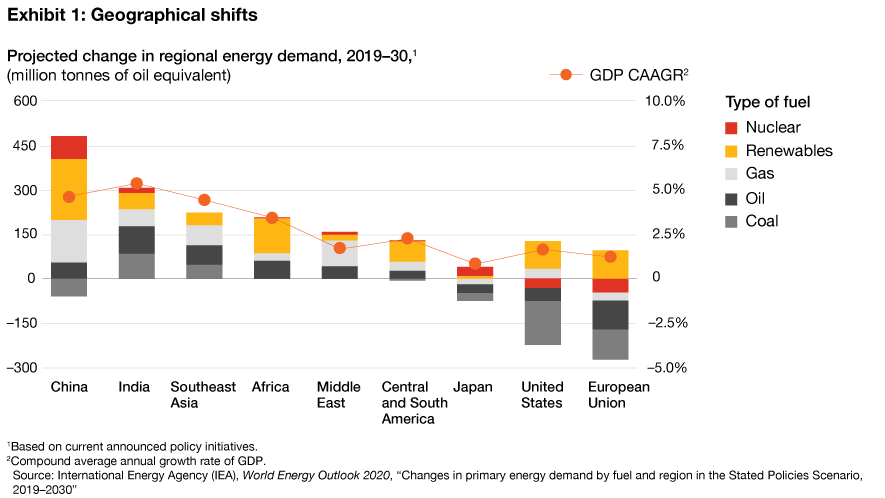
More than 190 countries have committed to the goals of the 2015 Paris Agreement, which include aggressive reductions in emissions. In 2020, investors poured a record US$350bn into sustainable investment funds, more than double the 2019 total. A great deal of capital is being invested into innovation, R&D, technology and scaling efforts that help bring down the cost of renewable energy production, energy storage, green hydrogen and other low- or no-carbon innovations.
Looking to the decade beyond 2030, renewable energy takes greater market share in the global electricity market, as coal declines and natural gas grows modestly. According to the IEA, by 2040, powered by strong growth in wind and solar, renewables will account for about 47% of the electricity market, up from 29% today. And of course, the ambitions of the world now aim to drive those trends even further (see Exhibits 2 and 3).
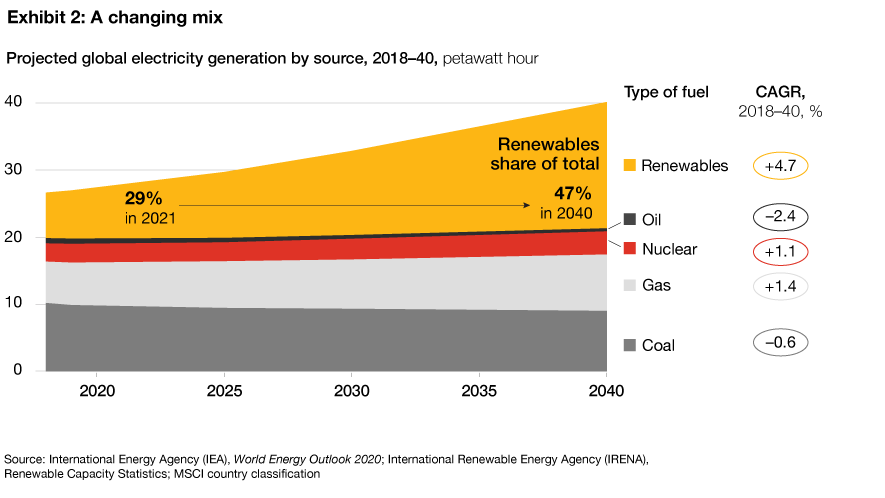
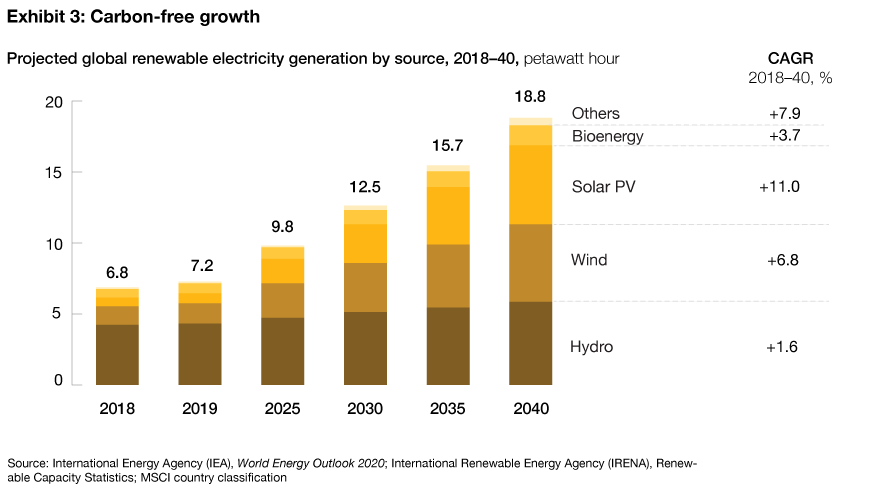
A new energy system: Lower carbon and higher complexity
The transition from our current energy system, which is dominated by fossil-fuel molecules (see Exhibit 4), into one based on renewable-powered electrons and fossil carbon–free molecules, has enormous implications and can be best understood by looking at the energy paths used. Despite all the investments made in renewables to date, oil, coal and natural gas still account for 80% of today’s energy. These energy sources produce electricity and provide refined products across the three core application areas that heat buildings, power factories and fuel most forms of transport. Carbon-free sources—renewable and nuclear—provide a small percentage of the electrons that power buildings and the transport sector.
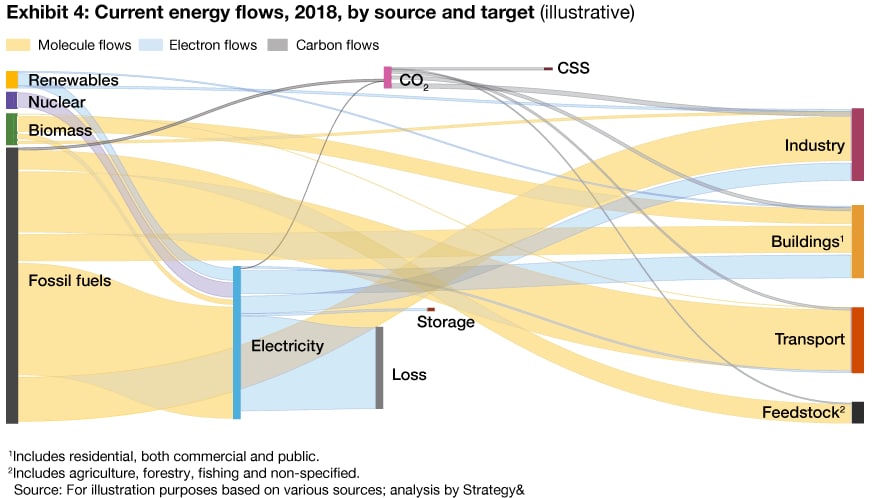
The future looks much different
As renewables gain market share and fossil fuels decline, the origins of electrons and molecules, and the paths they take, start to carve new paths (see Exhibit 5). By 2050, renewables will account for more than 90% of energy, and fossil fuels will account for less than 10%. Biomass and waste will surpass fossil fuels as creators of molecules that will be used to heat buildings and power transport and industry. In addition, the capturing and recycling of CO2 will create new flows of carbon molecules.
But electrons produced by renewables will be the dominant force in this system. They will provide the lion’s share of electricity, fill up massive batteries that will become electricity generators in their own right, power factories, heat and cool buildings and, as electrification hits the transport sector, emerge as a major fuel for cars, trucks, trains and ships. There will also be new paths for electrons to stimulate the creation of molecules—namely green hydrogen, which can function as a fuel for transport or a power source (see Exhibit 5). The final switch to a highly renewable energy system will require a quantum leap in storage for both electrons and molecules, and a rethinking of the role of baseload non-emitting technologies.
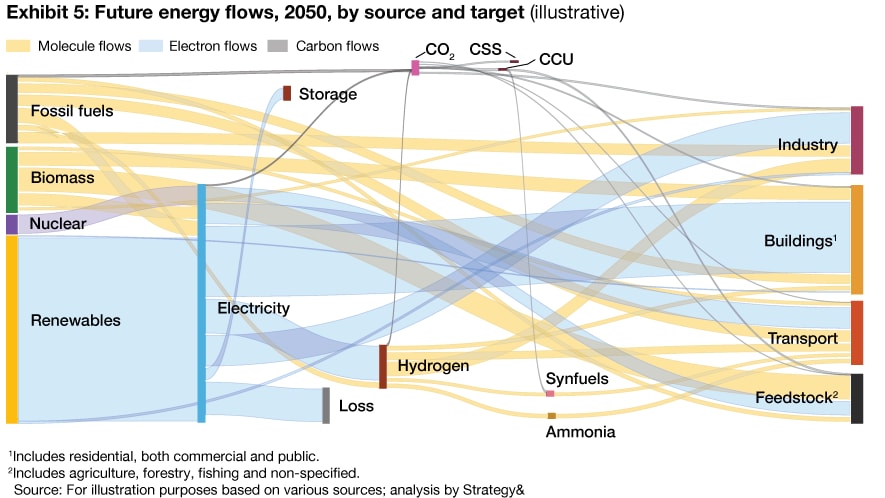
A system that is greener—but more complex
In the future, there will be more paths, more interactions and more transformation steps from generation to application. The greater presence of intermittent sources of power, such as wind and solar, will create challenges in aligning peak demand with production and ensuring reliability.
An additional layer of complexity is emerging in the industrial sector with the increasing push to decarbonise industrial processes and supply chains. This includes sharply rising demand for green power, the need to store electrons, and the need to transport green molecules. New value chains will emerge that link distributed power generation from renewables to demand centres, as well as carbon capture, recycling and storage (see Exhibit 6).
Another challenge will be the adoption of new ways to source carbon molecules for industries. Solving these challenges makes the conversion and storage of energy increasingly important and will flip the traditional role of the carbon molecule.

The new energy system will create a new landscape and paths for global energy. The development of renewable electrons and molecules is forging new trade routes, which will require substantial new investment. Projects have been proposed to build electricity transmission networks from areas that have vast capacity for renewable electricity production to centres of demand.
As predicted flows may change quickly, participants will struggle to manage the new energy system equilibrium and the high risks and volatility it will bring. A world that is less reliant on oil and coal is likely to present a new set of geopolitical dynamics. There will be an increasing political push around the world for self-sufficiency and strategic autonomy.
Strategic implications
It is unclear when the transition will conclude. But the direction of travel is clear, and the forces pushing in this direction are immense. The speed of change and the degree of complexity require a strategic response from all participants: national oil companies (NOCs), integrated oil companies (IOCs), utilities, chemical companies, service companies, investors, grid operators, and government entities such as ministries and regulators. For some players, especially the large oil companies, this transition poses existential questions. And a new crop of companies that historically have not been major players in the energy value chain— including battery companies, automakers and green hydrogen shippers—will find they need to adapt as well, because their inputs, supply chains and, in some cases, end products will change markedly over the next two decades. Those that embrace the new energy landscape and create new value from the underpinning disruption while decarbonising their value chains will create strategic and competitive advantage.
Convergence
First and foremost, the new paths carved by molecules and electrons will lead to greater convergence and an erosion of the traditional barriers between energy sectors. That will push companies to become more integrated (see Exhibit 7).

Utilities will have to delve into new business activities, such as data services and analytics, the financing and installation of household solar/charging solutions, and B2B behind-the-meter energy management. Chemicals companies identify hydrogen as an important production feedstock, energy source and business opportunity for their applications and they must reinvent themselves, focusing on harvesting, creating, capturing and recycling electrons and molecules in a circular fashion. Some of these moves are already underway. Integrated oil companies and transmission system operators—including Total, Shell, OMV and TenneT—have been investing substantially in the power sector.
Customers as value chain partners
One strategic dynamic at play relates to the role of customers and how they interact as value chain partners rather than as a traditional receiver of goods and services. Industrial companies and other large users already work with utilities to implement demand-response services. They can contract to reduce their usage during periods of peak demand and get paid for doing so. As renewable energy and storage become more prevalent, such balancing services will become increasingly common. Customers themselves may be able to turn themselves into providers of electrons. All players must take far-reaching decisions on how they position their activities and value propositions going forward, recognizing the strategic choices that are faced by each player in the energy value chain.
An increased need for state orchestration
There are many practical hurdles to overcome in several dimensions. Costs will need to come down, the right infrastructure investments must be made and new risks must be managed with constantly refreshed regulatory and operational standards and procedures. Just as these efforts require a rethinking of the paths and roles of molecules and electrons, they require a rethinking of the relationship between the market and the state.
Neither the government nor the private sector can manage the transition to net zero and the new energy landscape alone. Addressing these challenges will require strong state orchestration, at least in early stages during the development of markets and strategic infrastructure. The transition is simply too complex and too uncertain. What’s needed is a collective response—a combination of the state and market working together in new ways.
There are three possible models that we envisage being adopted around the world, in ascending order of degree of state involvement: policy driver, strategic infrastructure investor and co-investor.
- Policy driver
- Strategic infrastructure investor
- Co-investor
Policy driver
Government sets the vision for the energy system and uses the policy toolbox to guide and incentivise market players to cooperate, through subsidies, tax credits, regulation and climate taxes. This requires strong institutions with policy-making skills and independent regulation, long-term political commitment and deep know-how at the government level of the desired end state. This model has been the underpinning of energy markets in OECD countries and has been the staple diet for the majority of energy market policy advisers.
The road ahead
The next energy system is beautifully complex. Getting the energy transition right is vital in many dimensions: technological, strategic, environmental and economic. The scope of the required investments is starting to become clear and tangible, and so, too, are the benefits. Although the contours of the destination are starting to emerge, many challenges and questions remain as electrons and molecules find new pathways and new roles. It is clear that none of us can make this journey on our own. In all regions, in a range of industries, it will be critical to forge new alliances and develop novel ways of working together across value chains and ecosystems. Industries that were once clearly delineated will converge, transform and re-emerge in new forms.
The state and the market will have to work together in new ways, both leading and following at different moments, and traditional roles will need to be reconsidered. The exact choices players make is heavily dependent on historical and political context. For some, the collaboration will be familiar and for others it may feel uncomfortable. But the creative tension it unleashes will provide the force for innovation and development. If our systems are to deliver on the ambitious climate agenda the globe has set, the work must begin now.
Contact us

Global Energy, Utilities and Resources Leader, Partner, PwC Netherlands
Tel: +31-88-7921328



Global Energy, Utilities and Resources Industry Executive, PwC Germany
Tel: +49 211 981 4602















